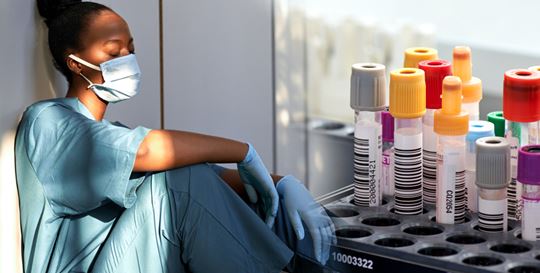Antibiotic Resistance: A Rising Global Concern
Infection with antimicrobial-resistant microbes is blamed for over 700,000 deaths per year globally, and with the continued rise of antimicrobial resistance, this number could top 10 million by 2050.1 The rise of antibiotic resistance jeopardizes our ability to treat common infections, and microbes previously considered innocuous are becoming deadly.2
A brief history of the antibiotic era
When the story of antimicrobials is told, most people think of the "antibiotic era" and begin the story with Alexander Fleming’s messy lab and the accidental discovery of penicillins in 1928. That said, there is evidence that tetracycline, an antibiotic commercialized in 1948,3 was used hundreds of years BCE, likely, as part of the diet to prevent infection.4 Similarly, the anti-malarial medication artemisinin (quinghaosu) has been used in Chinese medicine for thousands of years to treat multiple diseases.5 The first documented hospital use of an antimicrobial was by Emmerich and Löw in 1899;6 they used an extract from Pseudomonas aeruginosa that was active against multiple pathogens but was, unfortunately, highly toxic to humans.
The rise of superbugs
Superbugs, strains of microbes resistant to most drugs used for treating infections, threaten our ability to treat both simple and severe infections. As early as 1945, Fleming observed bacteria becoming resistant to penicillin, stating that "[t]he thoughtless person playing with penicillin treatment is morally responsible for the death of the man who succumbs to infection with the penicillin-resistant organism".7 Despite that warning, antibiotics are still prescribed when not needed. In 2016, the United States Centers for Disease Control and Prevention estimated that, of the antibiotics prescribed in outpatient settings, at least 30% of them were not needed.8
Historically, factory farming9,10,11 has accounted for approximately 80% of all antibiotic use, contaminating the environment and driving the evolution of superbugs. Clinically, the majority of antimicrobial resistance comes from misuse – patient non-compliance and over prescription. When prescribed appropriately, taking antimicrobials for infection can kill the invader, but when the full dose of the medication is not taken properly – because the patient forgets or because of adverse events – or when antibiotics are prescribed for viral infections, stronger survivors may be left behind. Any antibiotic use, whether needed or not, contributes to the rising rates of resistance.12 And the rise of resistance threatens everything from the safety and efficacy of surgical procedures to treating infections in immunosuppressed cancer patients.13
Microbes can become resistant to antimicrobials in a variety of ways. Bacteria can share DNA, often in the form of plasmids, containing genes that break down some antibiotics. And the more antibiotic-resistant bacteria there are, the faster the population of antibiotic-resistant bacteria rises. The top antibiotic-resistant microbes on the World Health Organization (WHO) watchlist include carbapenem-resistant Enterobacteriaceae (CRE; including Escherichia coli and Klebsiella pneumoniae) and Acinetobacter (including Acinetobacter baumannii), methicillin-resistant Staphylococcus aureus (MRSA), and multi-drug resistant Neisseria gonorrhoeae, Mycobacterium tuberculosis,14 and Clostridiodies difficile.15
Control measures
A good way to avoid the use of antimicrobials is to avoid infection. Two years of a pandemic brought awareness to best practices for infection control. Frequent handwashing, keeping hands away from the face and staying at home when ill are at the base of infection control both in and out of the hospital setting. Further, taking antibiotics only when necessary not only decreases potentially negative side effects but also decreases the likelihood of resistance formation.
The future of antibiotic resistance
Much work remains to be done to fight antibiotic resistance and keep us out of a post-antibiotic era. Since the introduction of penicillin as a treatment for bacterial infections almost 80 years ago, bacteria have eventually developed resistance against every antibiotic that has been identified.16 According to the WHO, "[d]evelopment of new antibiotics is almost at a standstill and the world is running out of antibiotics."17
But there is hope. One study18 showed that decreasing prescription of macrolide antibiotics for streptococcal infections led to a 50% reduction in macrolide resistance. And antibiotic stewardship programs have led to similar reductions in many other infectious agents.12 Further, in 2017, the Food and Drug Administration implemented a policy where antibiotics of medical importance – those that are needed for human treatment – cannot legally be given for animal growth promotion19,20 to help limit antibiotic resistance arising from food-producing animals.
WHO, along with their counterparts at the Food and Agriculture Organization of the United Nations, the United Nations Environment Programme, and the World Organisation for Animal Health, have determined that the only way to decrease antimicrobial resistance is the theme of this year’s World Antimicrobial Awareness Week is a global campaign: Preventing Antimicrobial Resistance Together. Designed to increase awareness of antimicrobial resistance and help reduce the spread and further emergence of drug-resistant microbes, WAAW is globally recognized November 18-24.

 English
English





